Species Description
Class: Dicotyledonous plant.
Family: Oxalidaceae (wood sorrel family).
Other Common Names: Yellow woodsorrel, yellow oxalis, upright yellow sorrel, shamrock, lucky clover, good luck plant.
Life Span: Cool-season (spring and fall) perennial that persist year-round in warmer climates.
Habitat: Often found in woodlands, grasslands, turf, disturbed sites, and drain holes of containers or on container media surface (Figure 1). Found in full-sun and partial-sun areas.
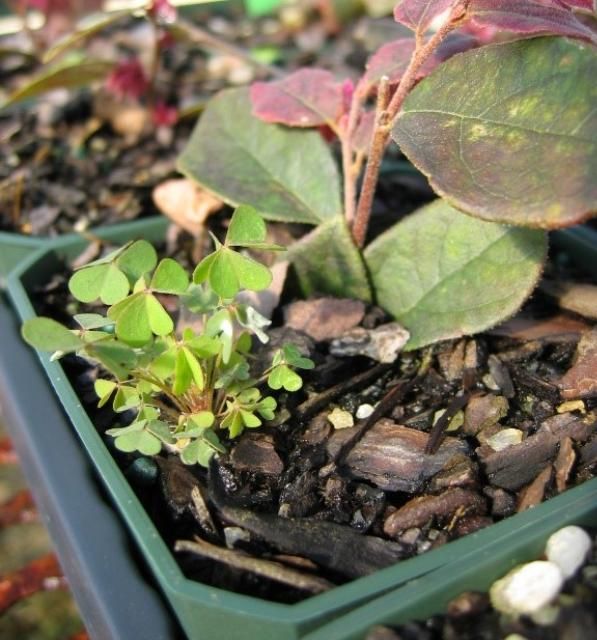
Credit: Chris Marble, UF/IFAS
Distribution: Oxalis is believed to be native to North America and is found in most of the eastern and central United States and is also present in Europe, Africa, Asia, Japan, and New Zealand.
Growth Habit: Usually erect (upright) and readily branching, but may also grow more prostrate (along soil surface). Often forms dense mats from rhizomes (horizontal underground stems that form lateral shoots and adventitious roots) (Figure 2).
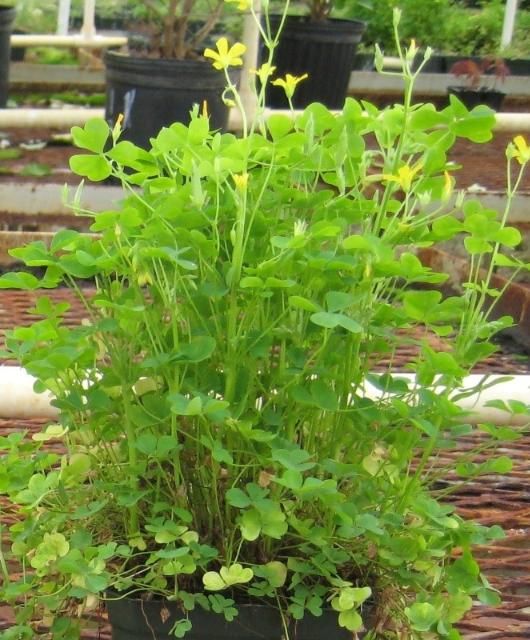
Credit: Chris Marble, UF/IFAS
Seedling: Cotyledons often have a pink tint with alternate, trifoliate leaves with thin, heart-shaped leaflets that are creased in the middle (Figure 3). Leaflets are smooth on the upper surface and have minimal pubescence (hair) on the lower surfaces and margins.
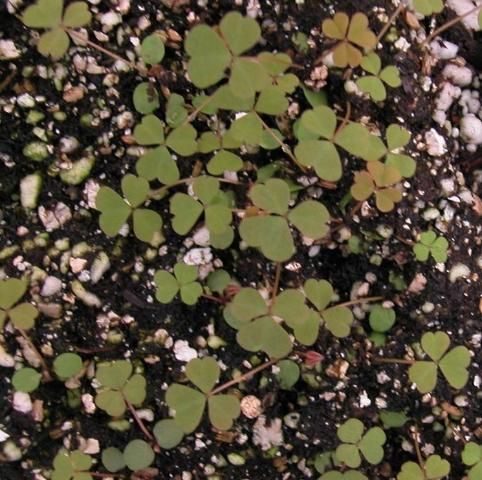
Credit: Chris Marble, UF/IFAS
Shoot: Stems are light green in color and slightly pubescent (hairy). Leaves are palmately compound, alternate, and light green, with entire (smooth) cordate (heart-shaped) leaflets that are 0.2 to 0.4 inches long and 0.2 to 0.4 inches wide.
Roots: Taprooted. Rhizomes form secondary fibrous root structure.
Inflorescence: Three flower stalks branch from a single main stalk, which arises from the leaf axils. Flowers are yellow, roughly 0.5 inches in diameter, and have 5 petals. Flowers from spring through fall (Figure 4).
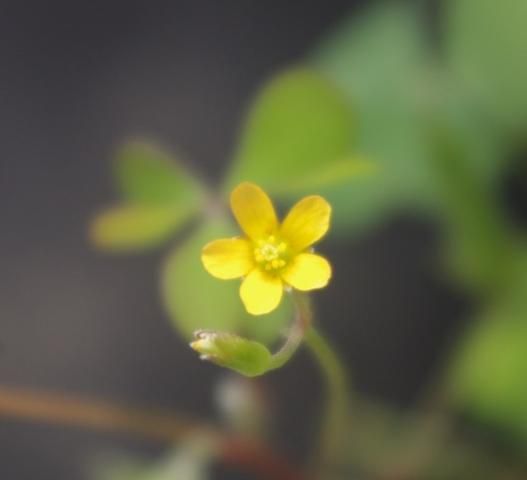
Credit: Annette Chandler, UF/IFAS
Fruit and Seeds: Capsule fruit, resembling the shape of okra pods, contain five ridges and are approximately 0.5 inches in length (Figure 5). Fruit are produced spring through fall. Seeds are flat, brown, and have a teardrop shape. Mature seed capsules explosively dehisce (expel) when touched.
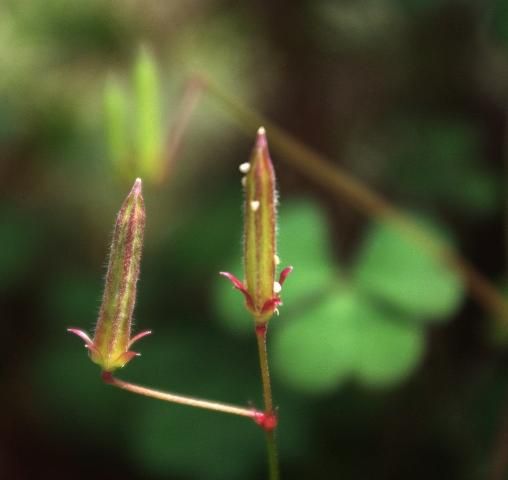
Credit: Annette Chandler, UF/IFAS
Similar Species: Several oxalis species are common weed pests in ornamental plant production. Creeping woodsorrel (Oxalis corniculata) is a similar species that grows more prostrate, often has darker green to purplish leaves, and produces stolons (aboveground plant stem that roots at nodes) (Hall, Vandiver, and Sellers 2012). O. corniculata has more pubescent foliage, especially along leaf margins. Florida yellow woodsorrel (O. florida) closely resembles O. stricta but has slender stems, larger leaves, and a smooth to slightly hairy seed capsule (Unruh et al. 2013). Cuban purple woodsorrel (O. intermedia) and pink sorrel (Oxalis debilis var. corymbosa) have larger leaves, purple flowers, and reproduce by bulbs and seed. Various Oxalis species are available commercially as ornamentals, including a vast assortment of Oxalis purpurea cultivars that have large, pink, showy flowers. Trifolium spp. (clovers) have similarly shaped leaves but have ball-like clusters of flowers and belong to a completely different plant family.
Plant Biology
Oxalis grows throughout the year in Florida (Neal and Derr 2005). Oxalis prefers moist soil but can grow in dry areas and in a variety of different soil types (Halvorson and Guertin 2003). Persistence in ornamental production and landscapes is due to its prolific seed production; a single plant may produce up to 5,000 seeds in a year. At maturity, seeds are dispersed from explosively dehiscent capsules up to 16 feet away from the parent plant and germinate quickly (Halvorson and Guertin 2003; Neal and Derr 2005). Newly developed seeds have been shown to have close to 100 percent germination soon after dispersal (Holt and Elmore 1985). Seeds require light to germinate and most germination occurs within a temperature range of 50°F to 84°F; however, seeds produced during warmer months have a broader germination temperature range than seeds produced during cooler months (Holt and Elmore 1985). Vegetative reproduction is prevalent in established populations from axillary buds at nodes located on rhizomes (Halvorson and Guertin 2003). Oxalis can be found growing in sidewalk cracks, alongside trails, in lawns, flower beds, cultivated fields, and in container nursery stock in a wide range of elevations (Halvorson and Guertin, 2003). In greenhouse studies, oxalis populations have been shown to negatively impact the growth rates of ornamental crops (Neal and Derr 2005).
Management
Physical and Cultural Control
Oxalis is most successfully controlled through hand weeding when plants are young (6 weeks or younger) and before seed capsules develop (Halvorson and Guertin 2003). It is nearly impossible to completely remove oxalis rhizomes and stolons once established in nursery containers (Neal and Derr 2005). Hand weeding should occur when soil is moist to avoid dislodging small ornamentals and to ensure that all vegetative portions (roots, rhizomes, etc.) are removed (Halvorson and Guertin 2003). Hand-pulled plants need to be removed from the field because any seeds left behind can continue to germinate. Shallow mulching can aid in suppressing germination by blocking seedling exposure to light (Holt and Elmore 1985). Oxalis is generally tolerant of mowing and can develop a more prostrate growth habit in areas that are repeatedly mowed (Halvorson and Guertin 2003). Rototilling mature oxalis can promote the initiation of new plants by spreading cut rhizomes and stems (Halvorson and Guertin 2003). Sanitation is the most effective method for oxalis control in nurseries and greenhouses (Neal and Derr 2005). Regularly scout for this weed and check all incoming plants and liners for presence of oxalis before placing them in production beds.
Chemical Control
Preemergence
Oxalis is controlled with most preemergent herbicides labeled for nursery and landscape use. Preemergence herbicides will not work if stolons, rhizomes, or root and stem fragments are left behind after hand weeding. Containers and planting beds need to be weed free at the time of application for preemergence herbicides to be effective. However, indaziflam (Marengo®, OHP, Inc.) can provide control of very small oxalis soon after it germinates, up to the four-leaf stage (Marble et al. 2013). Marengo® should be applied as a directed application. A partial list of preemergence herbicides labeled for use in and around ornamentals that provide control of oxalis is given in Table 1.
Postemergence
There are many different postemergence herbicides that are effective for oxalis control but most have to be applied as a directed application. Effective active ingredients include glyphosate (RoundUp®), glufosinate (Finale®), diquat (Reward®), and pelargonic acid (Scythe®), among several others. Both systemic and contact herbicides will provide effective control, but thorough coverage is needed for contact herbicides such as diquat or pelargonic acid. Postemergence herbicides are most effective when the weeds are small and actively growing. Always consult the manufacturer's label and follow all precautions when applying herbicides.
Disclaimer: Mention of a commercial or herbicide brand name or chemical does not constitute a recommendation or warranty of the product by the authors or the University of Florida, Institute of Food and Agricultural Sciences, nor does it imply its approval to the exclusion of other products that may also be suitable. Products should be used according to label instructions and safety equipment required on the label and by federal or state law should be employed. Pesticide registrations may change, so it is the responsibility of the user to ascertain if a pesticide is registered by the appropriate state and federal agencies for its intended use.
References
Hall, D. W., V. V. Vandiver, and B. A. Sellers. 2012. Creeping Wood Sorrel, Oxalis corniculata L. Southern Yellow Wood Sorrel, Oxalis florida Salisb. SP37. Gainesville, FL: University of Florida Institute of Food and Agricultural Sciences.
Halvorson, W. L. and P. Guertin. 2003. "Factsheet for: Oxalis stricta L." USGS Weeds in the West project: Status of Introduced Plants in Southern Arizona Parks. Tucson, Arizona.
Holt, J. and C. Elmore. 1985. "Oxalis—Biology and Control." Ornamentals Northwest Archives 9(2):6–8.
Mallory-Smith, C. A. and E. J. Retzinger Jr. 2003. "Revised Classification of Herbicides by Site of Action for Weed Resistance Management Strategies." WeedTech 17:605-619.
Marble, S. C., C. H. Gilliam, G. R. Wehtje, and M. Samuel-Foo. 2013. "Early Postemergence Control of Yellow Woodsorrel (Oxalis stricta L.) with Residual Herbicides." WeedTech 27:347–351.
Murphy, T. R. 2007. Weeds of Southern Turfgrasses. SP079. Gainesville, FL: University of Florida Institute of Food and Agricultural Sciences.
Neal, J. C. and J. F. Derr. 2005. Weeds of Container Nurseries in the United States. Raleigh, NC: North Carolina Association of Nurserymen, Inc.
Unruh, J. B., D. E. P. Telenko, B. J. Brecke, and R. Leon. 2013. Yellow Woodsorrel (Oxalis) Biology and Management in Turf. ENH1124. Gainesville, FL: University of Florida Institute of Food and Agricultural Sciences.